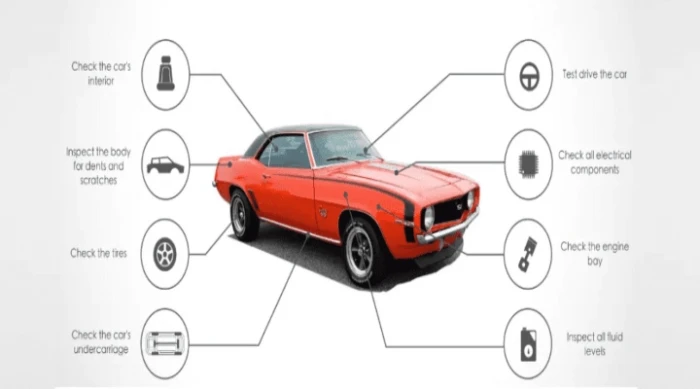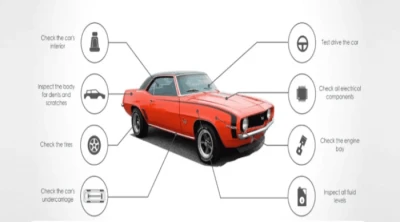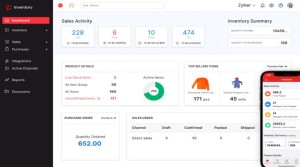Things You Should Must Check Before Buying a Used Vehicle
Buying a used car can save money, but being careful is essential. Some things need to be checked, such as whether you buy from a dealer or a person.

Buying a used car can save money, but being careful is essential. Some things need to be checked, such as whether you buy from a dealer or a person. These things will help you get a good car and avoid problems later. You need to look at the car’s engine and other parts. You must also ensure the vehicle is legal and has no money problems.
Vehicle's History Report
When considering buying a used car, you should check its history. This will tell you if the vehicle has been in an accident, got wet from a flood, or has any problems the carmaker has told people about. Services like CARFAX or AutoCheck offer comprehensive reports based on the vehicle’s VIN (Vehicle Identification Number). The history report can also reveal whether the car has a salvage title, which indicates significant damage in the past. If you know the vehicles, you can only buy one with problems you must learn about. These problems could cause the car to drive badly or be unsafe.
Title and Ownership Verification
Before finalizing the purchase, ensure the seller has a clear title to the car. Verify that the vehicle is on the seller’s name and has no liens i.e. outstanding loans. If the car was financed, it might still have a lien from the bank or lending institution, and this must be cleared before the ownership can be transferred. A clean title means the car hasn’t been stolen or involved in legal disputes. It’s also important to check the title’s accuracy, including details like the make, model, and VIN, which should match the car.
Mechanical Inspection
A thorough mechanical inspection is one of the most critical steps in assessing a used vehicle. If you don’t have expertise, hiring a professional mechanic to inspect the car is going to be a wise investment. Check the engine, transmission, brakes, how the car handles, and the exhaust system. Take the car for a drive to see if there are any strange noises or problems. Look at the car’s maintenance history to see if the previous owner took good care of it.
Vehicle’s Wear
The vehicle’s mileage plays a significant role in determining its value and longevity. High-mileage cars experience more wear and tear, leading to more frequent repairs. However, low mileage is only sometimes better, as some vehicles that are driven infrequently can develop mechanical problems due to lack of use. It is essential to compare a car’s mileage to the car’s age. Additionally, checking the odometer for any signs of tampering is vital, as some unscrupulous sellers may attempt to roll back the mileage to increase the chances of vehicle’s sale.
Exterior and Interior
When looking at a car, checking how well it works is essential. Check the car’s outside for any damage. Look for rust, dents, or scratches. These things can show if the vehicle was in an accident or not taken care of well. Heck, for uneven paint, which could suggest that car parts were repainted after a collision. Inspect the seats, dashboard, and upholstery for signs of excessive wear or damage. Also, you should check if the air conditioning, heating, power windows, and infotainment systems work correctly.
Tires and Suspension
Tire condition is an indicator of a car’s overall health. Look for uneven tire wear, which could suggest vehicle alignment or steering issues. A car that pulls to one side during test drive might also have alignment problems. Additionally, ensure the suspension is in good shape by parking down on the car’s corners; the vehicle should bounce back smoothly rather than continue bouncing, which could indicate worn-out shocks or struts.
Fluid Levels and Steaks
Fluids are the lifeblood of any vehicle. Before you buy a used car, check all the important liquids it needs to run. These liquids include engine oil, coolant, transmission fluid, brake fluid, and power steering fluid. Low fluid levels or dirty fluids could indicate poor maintenance. Also, inspect the ground beneath the vehicle for any signs of leaks, which might signal potential issues with the engine, transmission, or other components.
Price and Negotiation
Finally, the asking price of the used vehicle will be compared with its market value. Online tools like Kelley Blue Book can help determine the cost based on the car’s make, year, and condition. Once you understand the vehicle’s features and insights, you can use this information to negotiate a better deal.
Are you wondering how to figure out the horsepower in the vehicle’s engine? Finding the vehicle’s power output is simple with our engine horsepower calculator. You only need to enter the required information to receive immediate insights into the engine’s performance.
A Thorough Overview of the Checklist to Buy Used Vehicles
It’s essential to approach the process cautiously and be mindful of potential pitfalls. From researching the best-used car websites to performing a thorough vehicle test drive, a buyer must follow a detailed checklist to avoid costly mistakes. This guide outlines the key aspects to remember before purchasing a used car.
-
Researching the Best Used Car Websites
The first step in the process is to explore the best platforms that offer a variety of used vehicles. Most websites often provide helpful information, such as vehicle history reports and seller ratings, making it easier for buyers to make informed decisions. Some platforms also allow buyers to compare prices and set alerts for deals, giving them a competitive edge in finding a great bargain.
-
Vehicle Test Drive
Once a potential vehicle has been identified, the next crucial step is to take the car for a test drive. The test drive offers a real-time opportunity to assess the car’s performance, comfort, and overall condition. During the drive, pay attention to any unusual sounds from the engine, steering, or brakes. Test the car’s acceleration, braking, and maneuverability to ensure everything works smoothly. A test drive is about getting a feel for how the car handles and checking for any potential mechanical issues. Make sure to drive on different types of roads and under various conditions if possible.
-
Used Car Checklist
Every buyer should have a used car checklist to thoroughly evaluate the vehicle’s condition. This checklist should include checking the car’s exterior, interior, engine, and tires. Inspect the bodywork for damage or rust, especially around the wheel wells and door frames. Ensure the paint is consistent, and look out for mismatched panels, which might indicate previous accidents or repairs. The tires should have sufficient tread and even wear. Under the hood, the engine must be inspected for leaks, worn belts, or hoses. The oil, transmission fluid, and coolant levels must also be checked. A well-maintained engine bay can be a good indicator of how the previous owner took care of the vehicle. The odometer must also be inspected to verify that the mileage is consistent with the car’s age and condition.
-
Precautions When Buying a Used Car
One of the most important precautions when buying a used car is to review its history report. Services like Carfax or AutoCheck can provide information on the car’s previous owners, accident history, and any recalls or significant repairs. It’s essential to avoid cars with a history of major accidents or flood damage, as they could lead to expensive repairs down the road. Buyers should also be wary of overly aggressive sales tactics. Take your time to review the vehicle, and don’t rush into a decision. This can reveal hidden issues that may not be visible during a regular inspection or test drive. Lastly, ensure all necessary paperwork, such as the title, registration, and warranty documents, is in order before finalizing the deal.
-
Essential Things to Check
In addition to the above steps, buyers should always check the car’s VIN (Vehicle Identification Number) to ensure that it matches the papers the seller gave. Verify that the vehicle has no outstanding loans or liens that could create future legal complications. Please ensure the vehicle’s registration is current and no unpaid fines or penalties are attached. Finally, verify the car’s price by researching similar models to ensure you get a fair deal. Bargaining is common when buying a used vehicle, so don’t hesitate to negotiate the price based on your findings and the car’s condition.
Ideal Ways to Find Used Cars
Locating a trustworthy used car can be a challenging but worthwhile endeavor. Here are some great methods to streamline the procedure and guarantee you choose a prudent investment.
- Establish a Budget
Choose your spending limit before you begin your search. Add on extra expenses for things like taxes, insurance, registration, and possible repairs.
- Research Models
Determine which models and makes are best for you. Take into account variables like as safety ratings, reliability, cost of maintenance, and fuel efficiency. Online discussion boards and consumer reports are two excellent sources of information.
- Make Use of Internet Resources
Websites with many listings and filtering options include Autotrader, CarGurus, and Cars.com. To make well-informed judgments, you can read reviews, compare pricing, and look at vehicle history reports.
- Private Sellers and Local Dealerships
Check out your neighborhood dealerships that provide certified pre-owned programs. There are frequently warranties on these cars. As an alternative, look through private seller classified advertisements on websites like Craigslist or Facebook Marketplace, but proceed with caution and make sure the car is in good working order.
- Examine and Take a Test Drive
Always give the vehicle a visual inspection and do a test drive. Keep an ear out for odd noises and look for wear indicators. For a comprehensive inspection, it’s a good idea to employ a mechanic or bring along a qualified buddy.
- Examine Reports on Vehicle Histories
Important information regarding a car’s past, such as accidents, title status, and service history, is available through services like Carfax or AutoCheck. This action can assist you in avoiding possible dangers.
- Use Knowledge in Negotiation
Based on your investigation and the vehicle’s state, be ready to haggle over the price. Your greatest ally in negotiating a fair deal is knowledge.
You can locate a used car that fulfills your requirements and provides peace of mind by using the procedures listed here and have fun looking for an automobile.
Buying a used vehicle requires careful attention to detail and a systematic approach. Checking the vehicle’s history, mechanical condition, and exterior can minimize the risks associated with used car purchases. If you put in extra work now, you can avoid big problems and expensive repairs later. This will make sure you make a good choice with your money.

Buying a used car can save money, but being careful is essential. Some things need to be checked, such as whether you buy from a dealer or a person. These things will help you get a good car and avoid problems later. You need to look at the car’s engine and other parts. You must also ensure the vehicle is legal and has no money problems.
Vehicle's History Report
When considering buying a used car, you should check its history. This will tell you if the vehicle has been in an accident, got wet from a flood, or has any problems the carmaker has told people about. Services like CARFAX or AutoCheck offer comprehensive reports based on the vehicle’s VIN (Vehicle Identification Number). The history report can also reveal whether the car has a salvage title, which indicates significant damage in the past. If you know the vehicles, you can only buy one with problems you must learn about. These problems could cause the car to drive badly or be unsafe.
Title and Ownership Verification
Before finalizing the purchase, ensure the seller has a clear title to the car. Verify that the vehicle is on the seller’s name and has no liens i.e. outstanding loans. If the car was financed, it might still have a lien from the bank or lending institution, and this must be cleared before the ownership can be transferred. A clean title means the car hasn’t been stolen or involved in legal disputes. It’s also important to check the title’s accuracy, including details like the make, model, and VIN, which should match the car.
Mechanical Inspection
A thorough mechanical inspection is one of the most critical steps in assessing a used vehicle. If you don’t have expertise, hiring a professional mechanic to inspect the car is going to be a wise investment. Check the engine, transmission, brakes, how the car handles, and the exhaust system. Take the car for a drive to see if there are any strange noises or problems. Look at the car’s maintenance history to see if the previous owner took good care of it.
Vehicle’s Wear
The vehicle’s mileage plays a significant role in determining its value and longevity. High-mileage cars experience more wear and tear, leading to more frequent repairs. However, low mileage is only sometimes better, as some vehicles that are driven infrequently can develop mechanical problems due to lack of use. It is essential to compare a car’s mileage to the car’s age. Additionally, checking the odometer for any signs of tampering is vital, as some unscrupulous sellers may attempt to roll back the mileage to increase the chances of vehicle’s sale.
Exterior and Interior
When looking at a car, checking how well it works is essential. Check the car’s outside for any damage. Look for rust, dents, or scratches. These things can show if the vehicle was in an accident or not taken care of well. Heck, for uneven paint, which could suggest that car parts were repainted after a collision. Inspect the seats, dashboard, and upholstery for signs of excessive wear or damage. Also, you should check if the air conditioning, heating, power windows, and infotainment systems work correctly.
Tires and Suspension
Tire condition is an indicator of a car’s overall health. Look for uneven tire wear, which could suggest vehicle alignment or steering issues. A car that pulls to one side during test drive might also have alignment problems. Additionally, ensure the suspension is in good shape by parking down on the car’s corners; the vehicle should bounce back smoothly rather than continue bouncing, which could indicate worn-out shocks or struts.
Fluid Levels and Steaks
Fluids are the lifeblood of any vehicle. Before you buy a used car, check all the important liquids it needs to run. These liquids include engine oil, coolant, transmission fluid, brake fluid, and power steering fluid. Low fluid levels or dirty fluids could indicate poor maintenance. Also, inspect the ground beneath the vehicle for any signs of leaks, which might signal potential issues with the engine, transmission, or other components.
Price and Negotiation
Finally, the asking price of the used vehicle will be compared with its market value. Online tools like Kelley Blue Book can help determine the cost based on the car’s make, year, and condition. Once you understand the vehicle’s features and insights, you can use this information to negotiate a better deal.
Are you wondering how to figure out the horsepower in the vehicle’s engine? Finding the vehicle’s power output is simple with our engine horsepower calculator. You only need to enter the required information to receive immediate insights into the engine’s performance.
A Thorough Overview of the Checklist to Buy Used Vehicles
It’s essential to approach the process cautiously and be mindful of potential pitfalls. From researching the best-used car websites to performing a thorough vehicle test drive, a buyer must follow a detailed checklist to avoid costly mistakes. This guide outlines the key aspects to remember before purchasing a used car.
-
Researching the Best Used Car Websites
The first step in the process is to explore the best platforms that offer a variety of used vehicles. Most websites often provide helpful information, such as vehicle history reports and seller ratings, making it easier for buyers to make informed decisions. Some platforms also allow buyers to compare prices and set alerts for deals, giving them a competitive edge in finding a great bargain.
-
Vehicle Test Drive
Once a potential vehicle has been identified, the next crucial step is to take the car for a test drive. The test drive offers a real-time opportunity to assess the car’s performance, comfort, and overall condition. During the drive, pay attention to any unusual sounds from the engine, steering, or brakes. Test the car’s acceleration, braking, and maneuverability to ensure everything works smoothly. A test drive is about getting a feel for how the car handles and checking for any potential mechanical issues. Make sure to drive on different types of roads and under various conditions if possible.
-
Used Car Checklist
Every buyer should have a used car checklist to thoroughly evaluate the vehicle’s condition. This checklist should include checking the car’s exterior, interior, engine, and tires. Inspect the bodywork for damage or rust, especially around the wheel wells and door frames. Ensure the paint is consistent, and look out for mismatched panels, which might indicate previous accidents or repairs. The tires should have sufficient tread and even wear. Under the hood, the engine must be inspected for leaks, worn belts, or hoses. The oil, transmission fluid, and coolant levels must also be checked. A well-maintained engine bay can be a good indicator of how the previous owner took care of the vehicle. The odometer must also be inspected to verify that the mileage is consistent with the car’s age and condition.
-
Precautions When Buying a Used Car
One of the most important precautions when buying a used car is to review its history report. Services like Carfax or AutoCheck can provide information on the car’s previous owners, accident history, and any recalls or significant repairs. It’s essential to avoid cars with a history of major accidents or flood damage, as they could lead to expensive repairs down the road. Buyers should also be wary of overly aggressive sales tactics. Take your time to review the vehicle, and don’t rush into a decision. This can reveal hidden issues that may not be visible during a regular inspection or test drive. Lastly, ensure all necessary paperwork, such as the title, registration, and warranty documents, is in order before finalizing the deal.
-
Essential Things to Check
In addition to the above steps, buyers should always check the car’s VIN (Vehicle Identification Number) to ensure that it matches the papers the seller gave. Verify that the vehicle has no outstanding loans or liens that could create future legal complications. Please ensure the vehicle’s registration is current and no unpaid fines or penalties are attached. Finally, verify the car’s price by researching similar models to ensure you get a fair deal. Bargaining is common when buying a used vehicle, so don’t hesitate to negotiate the price based on your findings and the car’s condition.
Ideal Ways to Find Used Cars
Locating a trustworthy used car can be a challenging but worthwhile endeavor. Here are some great methods to streamline the procedure and guarantee you choose a prudent investment.
- Establish a Budget
Choose your spending limit before you begin your search. Add on extra expenses for things like taxes, insurance, registration, and possible repairs.
- Research Models
Determine which models and makes are best for you. Take into account variables like as safety ratings, reliability, cost of maintenance, and fuel efficiency. Online discussion boards and consumer reports are two excellent sources of information.
- Make Use of Internet Resources
Websites with many listings and filtering options include Autotrader, CarGurus, and Cars.com. To make well-informed judgments, you can read reviews, compare pricing, and look at vehicle history reports.
- Private Sellers and Local Dealerships
Check out your neighborhood dealerships that provide certified pre-owned programs. There are frequently warranties on these cars. As an alternative, look through private seller classified advertisements on websites like Craigslist or Facebook Marketplace, but proceed with caution and make sure the car is in good working order.
- Examine and Take a Test Drive
Always give the vehicle a visual inspection and do a test drive. Keep an ear out for odd noises and look for wear indicators. For a comprehensive inspection, it’s a good idea to employ a mechanic or bring along a qualified buddy.
- Examine Reports on Vehicle Histories
Important information regarding a car’s past, such as accidents, title status, and service history, is available through services like Carfax or AutoCheck. This action can assist you in avoiding possible dangers.
- Use Knowledge in Negotiation
Based on your investigation and the vehicle’s state, be ready to haggle over the price. Your greatest ally in negotiating a fair deal is knowledge.
You can locate a used car that fulfills your requirements and provides peace of mind by using the procedures listed here and have fun looking for an automobile.
Buying a used vehicle requires careful attention to detail and a systematic approach. Checking the vehicle’s history, mechanical condition, and exterior can minimize the risks associated with used car purchases. If you put in extra work now, you can avoid big problems and expensive repairs later. This will make sure you make a good choice with your money.
Conversation
Latest Blogs
© Blog CoolCalculator, Explore CoolCalculator, your destination for the latest insights, tips, and updates on the world of online calculators. Stay informed and make your calculations smarter with our blog. ,
Designed
by Saad Media Team , Team Lead M.Rizwan Akhtar












